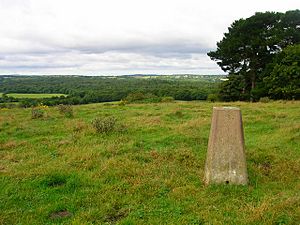Briddlesford Copses facts for kids
| Site of Special Scientific Interest | |

Trig point on the hill north of Havenstreet, looking in a south westerly direction towards Briddlesford Copse
|
|
| Area of Search | Isle of Wight |
|---|---|
| Grid reference | SZ549904 |
| Interest | Biological |
| Area | 167.2 hectare |
| Notification | 2003 |
| Location map | Natural England |
Briddlesford Copses is a special area of woodlands on the Isle of Wight in Britain. It covers about 167 hectares, which is like 230 football fields! This area is super important for nature. It's known as a Site of Special Scientific Interest (SSSI) and a Special Area of Conservation (SAC). These titles mean the land and its wildlife are protected by law.
Contents
Why Briddlesford Copses is Special
Briddlesford Copses is a very important place for wildlife. It was given its special protection status in 1995. This was mainly because of a rare type of bat that lives there.
Home to Rare Bechstein's Bats
One of the main reasons Briddlesford Copses is protected is its population of Bechstein's bats. These bats are quite rare in Europe. They are known for their long ears and their love for old woodlands. The bats use the trees in the copses to roost and raise their young. Protecting this area helps these amazing creatures survive and thrive.
What are Copses?
The word "copses" means small groups of trees or woodlands. Briddlesford Copses is made up of several of these wooded areas. These woodlands provide a perfect home for many different plants and animals.
Protecting Nature's Treasures
Most of Briddlesford Copses is part of the Briddlesford Nature Reserve. This reserve is looked after by a group called the People's Trust for Endangered Species (PTES).
The Role of PTES
The PTES is a charitable organisation. This means they are a non-profit group that works to help animals. Their main goal is to protect endangered species and their habitats. By managing Briddlesford Nature Reserve, PTES helps keep the woodlands healthy. This ensures the Bechstein's bats and other wildlife have a safe place to live. They work hard to make sure these special places are preserved for the future.

